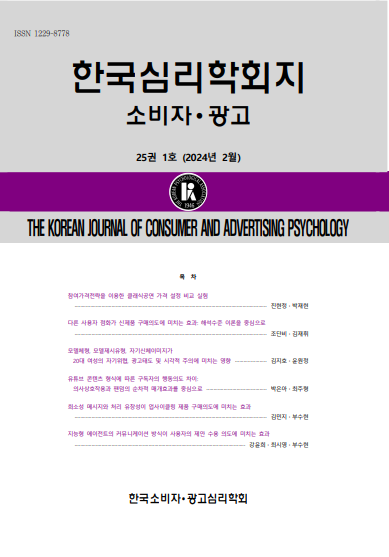open access
메뉴.png)
open access
메뉴 ISSN : 1229-8778
ISSN : 1229-8778
본 연구에서는 HMR(가정식대체식)에 대한 태도와 허용정도를 살피고, 이 두 변수가 실제 구매에 미치는 영향에 대해 분석하였다. 총 701명의 응답 자료를 바탕으로 구조방정식을 이용해 연구가설을 검증하였다. 응답자들이 일주일 21번의 식사 중 HMR을 최대로 허용하는 횟수는 평균 4.55 그리고 HMR을 실제 섭취하는 횟수는 평균 3.58로 나타났다. 분석 결과를 보면, 나이가 많을수록 상대적으로 HMR에 대한 태도가 부정적인 것으로 나타났다. 한편 규칙적 식생활 및 영양 추구 그리고 편의성 추구가 높을수록 HMR에 대한 태도가 긍정적으로 나타났으며, 긍정적인 태도는 허용정도를 높이고, 결과적으로 실제 HMR 섭취가 많아지는 것으로 나타났다. 식품안전 및 품질 추구는 일반적인 예상과는 달리 HMR에 대한 태도에 영향을 미치지 않은 것으로 나타났다. 본 연구는 심리적인 측면에서 HMR 소비를 분석하였다는 데에 의의가 있으며, 분석 결과는 HMR 개발 시 주된 타깃층 선정과 제품의 컨셉을 잡는데 중요 정보로서 활용될 수 있을 것으로 기대된다.
This study analyzed consumers’ attitude to HMR(home meal replacement), their allowance of HMR, and effects of the variables on actual HMR purchase. Based on responses from a total of 701 people, research hypotheses were tested using the structural equation model. Of 21 meals per each week, the average meal allowed for HMR in respodents’ mind was 4.55 and the average actual intake of HMR was 3.58. Empirical results show that as respodents are older, they are more negative toward HMR. Having a higher tendency of pursing regular diet, nutrition diversity, and convenience in meal caused to increase positive attitude to HMR. It was also shown that positive attitude increased acceptance of HMR on consumers’ mind, resulting in higher actual HMR purchase. The pursuit of food safety and quality has not, contrary to the general expectation, affected attitude to HMR. This study is significant in that it is the first to combine consumers’ phycological aspects with HMR consumption. The results are expected to serve as a basis for selecting target groups and conceptualizing HMR products.
본 연구는 정보의 제시 순서 효과가 소비자의 정보처리 습관과 밀접한 관련성을 가지고 있으므로 소비자들이 친숙하고 관용적으로 익숙한 순서로 정보를 처리할 때, 정보처리 유창성을 느끼며, 대상에 대하여 호의적으로 평가하게 될 것임을 제안하였다. 본 연구는 주재료와 최종제품을 순차적으로 모두 제시하는 상황에서 그 제시 순서에 따라 제품의 평가가 상이할 수 있다는 것을 제안하며, 동일한 정보들이 제공된다 하더라도 정보의 제공 순서를 달리 조작함으로써 소비자 평가가 달라질 수 있음을 다루었다. 특히, 본 연구는 특정 성별(여성)을 표적으로 하는 제품을 평가하는 상황에서 앞서 예측한 결과를 검증하였으며, 이 결과는 제품 친숙도를 대표하는 성별에 의해 조절됨을 제안하였다. 이를 검증하기 위해 두 가지 실험을 진행하였다. 실험 1은 올리브 비누를 이용하여 앞서 제안한 주재료와 최종제품의 제시 순서와 성별이 제품 평가에 미치는 상호작용 효과를 확인하였다. 그 결과, 남성 소비자는 주재료가 먼저 제시되고 최종 제품이 나중에 제시되는 경우 그 역순으로 제시되는 경우보다 제품을 더 호의적으로 평가한 반면, 여성 소비자는 정보의 제시 순서에 의해 제품 평가가 영향을 받지 않았다. 실험 2는 아몬드 밀크를 자극물로 사용하여 실험 1의 결과를 다시 검증하였고, 이러한 영향력이 정보처리 유창성에 의해 매개된다는 것을 확인하였다. 본 연구는 정보의 제시 순서가 소비자의 지각 및 평가에 미치는 영향력을 마케팅 상황에 적용하고 영향력을 고찰했을 뿐 아니라 특정 성별을 표적으로 하는 제품을 평가하는데 있어서 성별을 제품에 대한 친숙성의 조작화 변수로 활용하여 조절 효과를 검증했다는데 학문적인 의의가 있다. 논문의 결과는 성별을 기반으로 표적을 확대할 때, 정보의 제시 순서를 조작하는 것만으로도 마케팅 커뮤니케이션 효과를 극대화할 수 있음을 시사하며 실무적인 의사결정을 할 때 유용하게 이용될 수 있을 것으로 기대한다.
This research examines the potential interaction effect of information order and gender on attitude toward final product. More precisely, when consumers evaluate a female-targeted product, men tend to have a more favorable attitude toward the final product when the raw material is presented first than when the final product is presented first. On the other hand, women generally do not respond differently to different information order because the product is familiar to them. Processing fluency has been suggested as the underlying mechanism by which this process occurs. We tested the proposed interaction effect in two laboratory studies. In study 1, in which participants evaluate a soap made from olive oil, we investigated the interaction effect between information order and gender on product attitude. Study 2 replicates the information order and gender interaction effect using a different product stimulus (i.e., almond milk). The results show that the observed effect is mediated by an increase in processing fluency, which was also verified. The results provided an understanding of how consumers respond to time-laden information order-related gendered products and highlight implications for marketers seeking to increase the effectiveness of marketing communication.